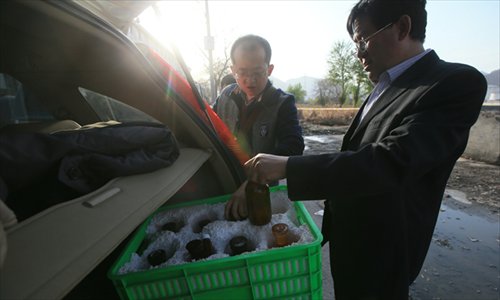Blasts blamed for toxic water contamination

Two staff members from the local environmental protection bureau test samples of water at the contamination site in Lanzhou, Northwest China's Gansu Province on Saturday. Photo: CFP
Explosions years ago at a plant owned by oil giant China National Petroleum Corp (CNPC) may have been the cause of severe tap water contamination in Lanzhou, Northwest China's Gansu Province.
The high levels of benzene measured in tap water caused panic among local residents over the weekend and triggered questions over "slow reactions" from authorities and the local water supplier.
According to preliminary results of an investigation by Lanzhou government Sunday, the water source for a local water plant was poisoned by oil pipeline leaks resulting from two explosions at a Lanzhou Petrochemical Company plant, a subsidiary of CNPC. The blasts occurred in 1987 and 2002.
As a result of the explosions, at least 34 tons of chemical residues were absorbed into the ground which then polluted an underground water duct opposite the site of the explosions.
CNPC could not be reached for comment as of press time.
Tests on Thursday and Friday found between 118 micrograms to 200 micrograms of benzene per liter of tap water, far in excess of the national limit of 10 micrograms, according to the city's environmental watchdog.
Benzene is known to damage the human blood cell production system.
By Sunday morning the water quality finally reached national standards for benzene, according to data released by Lanzhou government, but questions from the public into the incident did not end.
The water processing plant from Lanzhou Veolia Water Company, a Sino-French joint venture and the sole water supplier for urban Lanzhou, detected suspicious levels of benzene at 5 pm on Thursday but water supply through the duct was not cut until 18 hours later at 11 am Friday. The city government then warned residents not to drink the tap water for 24 hours.
Many residents questioned why there was such a long delay before the public were notified and the supply cut.
"The company has no right to cut water supply … We can only report it to the government and let them decide," Tian Huaqiang, head of the news office in Lanzhou Veolia Water, told the China Youth Daily.
It normally takes eight and a half hours for the water to reach urban households from the duct. Many residents drank the contaminated water before they were aware of a problem, the paper said.
A source from Veolia Water, who asked to remain anonymous, told the Global Times that the test for benzene levels is complicated and they need to evaluate repeatedly to confirm any pollution before cutting the supply.
"We have used a lot activated carbon to absorb the benzene after detecting the problem," the source said.
The source said that the No.4 culvert, the one which was contaminated among the four used by Veolia in Lanzhou, is made of concrete. It was eroded by the contaminants left in the soil after the polluting incidents.
The culvert has been in use for almost 60 years, but was repaired in 2008 by the local government. The company did not receive any notice from the government saying the duct should be renewed, the source added.
This is the second incident of its kind in Lanzhou in two months. On March 6, residents reported a strange odor when they turned on their taps, which was later confirmed to be a high concentration of ammonia, but still within national standards.
A Lanzhou Morning Post article on March 8 said that the government not only managed to closely monitor water quality and release data in time, but also cleared the panic among citizens, cracking down on people who spread rumors.
Local resident Du Li told the Global Times that the government has lost its credibility after many people have connected the two incidents together.
A villager in Xigu district, the most affected area in the most recent incident, told the Beijing-based Legal Mirror that their tap water has tasted strange for at least two weeks.
Environmentalist Ma Jun, director with the Institute of Public and Environmental Affairs, told the Global Times that a major problem revealed by the accident is that irrational city planning caused the water supply system to be sited close to petrochemical plants.
"The CNPC factories should also be more disciplined. We can also understand now why so many Chinese people are so alert to chemical plants being constructed close to people's homes," Ma said.
There have been many previous explosions and oil leaks, and this incident has further convinced people they are dangerous, he said.
In November 2013, a pipeline owned by State-owned oil company Sinopec leaked, causing an explosion in Qingdao, Shandong Province, resulting in the deaths of 62 people.